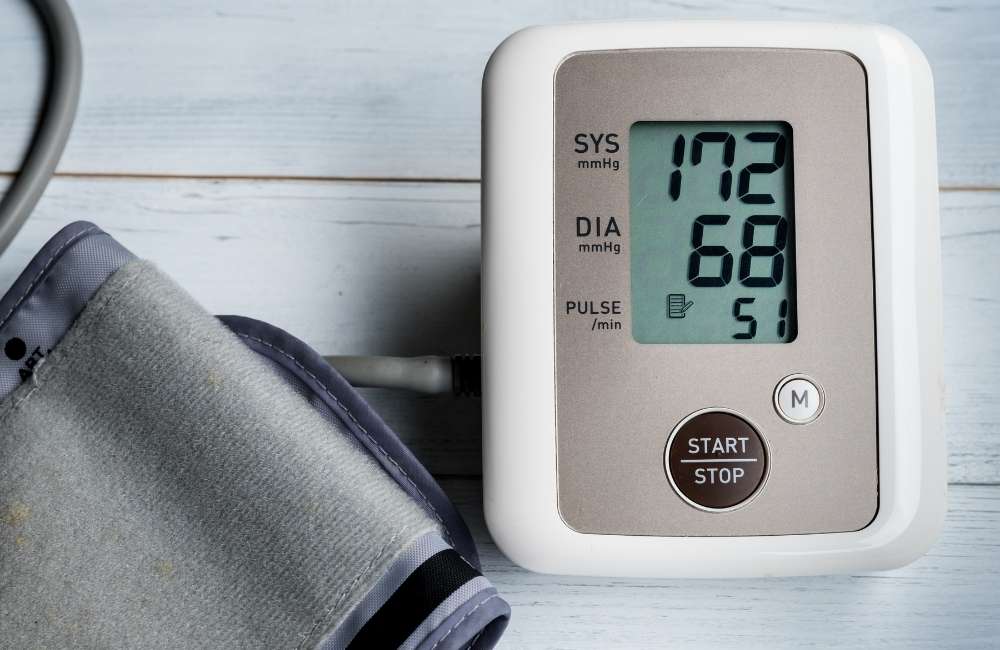Hypertension, also called high blood pressure is blood pressure that is higher than normal. First, it is very important to understand what Blood pressure is. The heart is a muscular organ situated at the centre of the chest and points slightly towards the left. Its main function is to ‘Pump’ blood around the body through a network of tubes called arteries and veins.
The heart pumps the blood through the arteries and the pumped blood returns to the heart through the veins. This pressure is created by the force exerted by the circulating blood against the walls of the body’s arteries.
The first number, called systolic blood pressure, measures the pressure in your arteries when your heart beats and the second number, called diastolic blood pressure, measures the pressure in your arteries when your heart rests between beats.
What is Hypertension?
Guidelines from the European Society of Cardiology and the European Society of Hypertension define hypertension as a blood pressure reading from 140/90 mmHg.
Although the average blood pressure for a person remains constant, however, it shows minor fluctuations throughout the day- lower or declining while relaxing and momentarily increasing while being excited or under stress.
Understanding your Blood Pressure Reading
Blood pressure is written as two numbers. The first and upper number represents the Systolic pressure while the lower and second number is the Diastolic Pressure. e.g. 120/80 (120 is systolic while 80 is diastolic).
In French-speaking countries, zero is removed from both the Systolic and Diastolic readings thus a blood pressure of 180/140mmHg is written as 18/14 in French.

Stages / Categories of Hypertension
| CATEGORY | SYSTOLIC | DIASTOLIC |
| Normal | 120 or Less | 80 or Less |
| Pre-Hypertension or elevated | 120-129 | 80 or less |
| Stage 1 | 130-139 | 80 89 |
| Stage 2 | 140-159 | 90-99 |
| Hypertensive Crisis | 180 or Higher | 120 or Higher |
Hypertension can also be classed as Primary when the cause is not known and secondary when there is a causative factor.
Global Perspective
Hypertension is a global health crisis. More than 1 billion people have hypertension all over the world.
In 2015, the World Health Organization estimated that hypertension affected 25% of men and 20% of women.
Hypertension is the number one risk factor for Death. It drastically increases the risk of Heart attack, stroke, Heart Failure and Kidney Failure accounting for 12.8% of Deaths globally.
Epidemiology
Many countries have a high burden of Hypertension. Studies showed a closing up of the rural-urban gap previously reported and significant public health and economic threat.
Growth in population, a move towards more urban living, and changes in lifestyle including diet have contributed to this dramatic growth.
What are the Risk Factors for Hypertension?
There are 2 types of factors namely

- Modifiable risk factors
These are modifiable behaviours or exposures that can raise or lower one’s risk of being Hypertensive. They include:
-
- Unhealthy diets
- Excessive salt consumption.
- A diet high in saturated fat and Trans fats.
- Low intake of fruits and vegetables.
- Physical inactivity.
- Consumption of tobacco or weeds.
- Alcohol intake.
- Being overweight or obese.
- Non-Modifiable- factors
These are factors that cannot be changed. They include:
-
- A family history of hypertension.
- Increasing Age.
- Co-existing diseases such as diabetes or kidney disease.
Hypertension Symptoms
Hypertension is called the “silent killer” because most people with hypertension are unaware of the problem. After all, it may have no warning signs or symptoms. For this reason, blood pressure must be measured regularly.
The ‘Lucky ones’ with symptoms may present with the following viz:
- Severe headaches.
- Nose bleed.
- Fatigue or confusion.
- Vision problems.
- Chest pain.
- Difficulty breathing.
- Irregular heartbeat.
- Blood in the urine.
- Pounding in your chest, neck, or ears.
Diagnosis of Hypertension
The diagnostic threshold for hypertension remains 140/90 mmHg on clinic blood pressure. The gold standard is ambulatory BP monitoring (ABPM) but, as this is not suitable or tolerated by everyone, home BP monitoring (HBPM) is offered as an alternative. For HBPM, patients should be advised to take at least two recordings, 1 minute apart, twice a day for 4 to 7 days. The first day of readings should be discounted and the mean of the remaining readings used. If the mean BP is close to the diagnostic threshold, ABPM may be needed to confirm the diagnosis,
BP should be checked in both arms at the time of diagnosis as a significant difference in readings between arms is an important marker of vascular disease and can lead to under-treatment A difference of 15 mmHg is considered significant and BP should be measured consistently in the arm with higher BP during subsequent monitoring where possible.
Please note the following concerning hypertension diagnosis
- White-coat hypertension. Occurs when the blood pressure readings at your doctor’s office are higher than they are in other settings.
- Hypertensive Emergency – Marked raised Bp with evidence of organ damage.
- Hypertensive Urgency – Marked raised Bp without evidence of organ damage
- Pregnancy-induced hypertension – High blood pressure that occurs in pregnancy.
- Chronic Hypertension in Pregnancy – Hypertension preceding the pregnancy.
- Metabolic syndrome – Hypertension + Diabetes + Obesity + raised cholesterol or triglyceride levels
Prevention of Hypertension

Preventing high blood pressure starts with making lifestyle adjustments such as
- Eating Healthy Diet.
- Maintaining a Healthy Weight.
- Being Physically Active.
- Drinking water and staying properly hydrated (also helps in maintaining healthy blood pressure).
- Limiting Alcohol intake.
- Getting Enough Sleep.
- Stopping smoking and last but not least.
- Regular Blood pressure checking.
Although anxiety can’t cause chronic hypertension, there’s a definite connection between anxiety and blood pressure. Anxiety leads to a natural increase in blood pressure due to the fight-or-flight response, and high blood pressure can sometimes also lead to an increase in anxiety.
The Unmet Need
Around the world, levels of diagnosis, treatment and control o Hypertension remain relatively low. Less than 20% of persons with hypertension are under control.
Management of Hypertension
Management of Hypertension starts with making a proper diagnosis and counselling the patient about starting medication.
Recommendation on Blood Pressure Threshold for Initiation of Pharmacological Treatment
- Individuals with a confirmed diagnosis of hypertension and systolic blood pressure of ≥140 mmHg or diastolic blood pressure of ≥90 mmHg.
- Individuals with existing cardiovascular disease and systolic blood pressure of 130–139 mmHg
- Individuals without cardiovascular disease but with high cardiovascular risk, diabetes mellitus, chronic kidney disease, and systolic blood pressure of 130–139 mmHg.
Laboratory Tests to Determine Initiation of Treatment
It is important to note that before treatment is commenced that some laboratory investigations are carried out to rule out medical conditions that are simultaneously present ( called co-morbidities)
- Serum electrolytes and creatinine and estimated glomerular filtration rate (eGFR)
- Lipid panel or profile.
- Glycosylated Hemoglobin (HbA1C).
- Fasting blood Sugar.
- Urinalysis.
- 12 Lead Electrocardiograms (ECG).
Drug and Dose-Specific Protocols
This is to be discussed with your Physician. There are different classes of Anti Hypertensive drugs and their combinations.
Conclusion
Hypertension is a “silent killer. You may not have warning signs or symptoms. For this reason, blood pressure must be measured regularly and a healthy lifestyle is advised.

